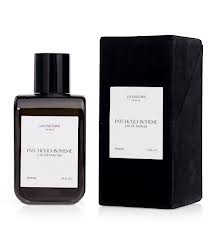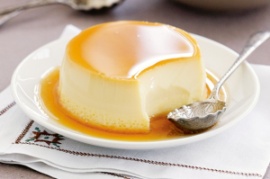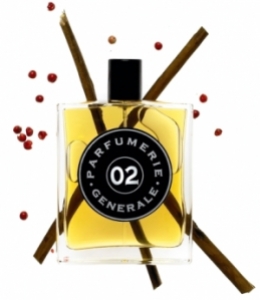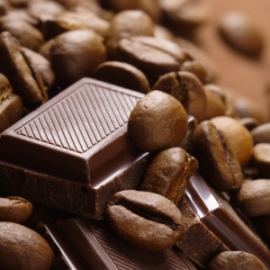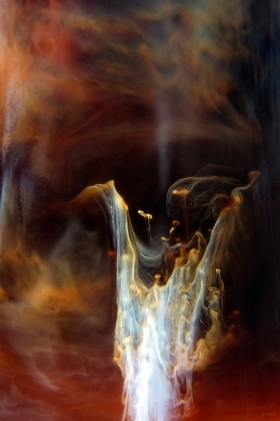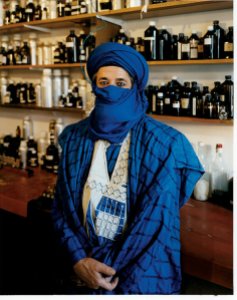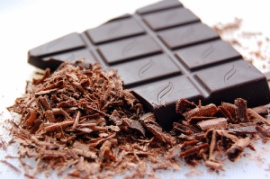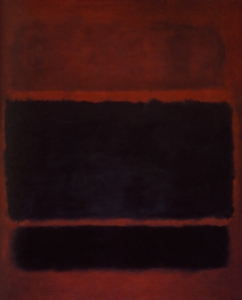
Photo: “Fiery Mesquite Sunset” by Delusionist on Deviant Art. http://delusionist.deviantart.com/art/Fiery-Mesquite-Sunset-13859523
The smoky sweetness of singed woods and a mesquite barbecue are the beginning of a woody perfume that later transforms into an absolutely lovely, cozy cloud of caramel amber, darkened resins, balsams, and dry vanilla. It is the most unusual “patchouli” fragrance that I’ve ever encountered: Patchouly Boheme from LM Parfums.
Patchouly Boheme is an eau de parfum released in 2011. It is frequently spelled as “Patchouli Boheme” on various sites, including Fragrantica and many retailers, but I will go with the company’s own spelling of the fragrance. The perfume was created by the late Mona di Orio, a very close, personal friend of Laurent Mazzone, LM Parfums’ founder. Her touch definitely shows, especially in the strong vein of cozy caramel flan that appears at one point in Patchouly Boheme and which is the centerpiece of her other creation for LM Parfums, Ambre Muscadin.
LM Parfums describes Patchouly Boheme and its notes as follows:
The Pathouly Bohème, sensual and insolent dressed in precious woods, spices intoxicating …
It sows confusion, mystery, we hugged its wake profound and haunting, like a play of shadows and light with hints of leather, tobacco, resin tolu and tonka bean …Top notes: geranium leaves Egypt, precious wood
Heart Notes: patchouli indonesia, virginia tobacco, leather
Base notes: musk, tolu balm, tonka bean.
Patchouly Boheme opens on my skin with smoky woods that are exactly like mesquite and a mesquite barbecue on my skin. It is immediately followed by an amber-vanilla accord that is the precise same one that lies at the heart (and drydown) of Ambre Muscadin and which I found to smell like a delicious caramel flan. Just as in Ambre Muscadin, the smell here in Patchouly Boheme is also infused with cedar, but it is not nearly as dominant. It also lacks the musk aspects of Ambre Muscadin.
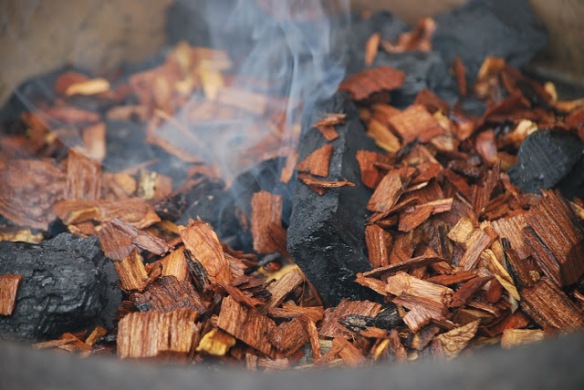
Mesquite wood chips on coal. Source: My Story in Recipes blogspot. http://mystoryinrecipes.blogspot.com/2012/08/grill-smoked-chicken.html
The main chord in Patchouly Boheme’s opening, however, is that mesquite wood. As Wikipedia explains, Mesquite is a type of wood common to the American Southwest, northern Mexico, Texas, and parts of South America. I live in an area where mesquite barbecues are extremely common, if not the characteristic type of barbecue for the region. Mesquite is such a big deal here that even deli foods like ham, turkey, cheese, and potato salads come with smoky mesquite flavouring. I highly doubt the same is true in London, Paris, or New York, so you have to put my issues into that context to understand why the note in Patchouly Boheme is difficult for me. I absolutely adore patchouli in all its true, original, brown facets, but nothing in the perfume’s first few hours translates as that sort of patchouli to me. No, it’s primarily mesquite wood that is singed and sweetened.
If I’m to be honest, I actually recoiled the first time I smelled Patchouli Boheme’s opening. And the second time, too. In both instances, I clung on primarily because of how much I love the caramel flan note that lies behind it, as if coyly veiled by a thin curtain of smoking woods. Plus, I was fascinated (and completely bewildered) by smelling Texas mesquite in a French perfume so clearly done by Mona di Orio. Had she been to the American Southwest? How did she decide that the unnamed “precious woods” in her perfume should be mesquite of all crazy things??!
The third time I tried Patchouly Boheme, I still didn’t like it very much, but I’d become rather addicted to the cozy comfort of the caramel amber flan, not to mention the stellar drydown. (It really is stellar!) So, I basically decided to ignore the difficult 40 minutes or first hour in order to get to the delicious rest. In truth, it’s taken me a good 7 wearings to smoothly move past that beginning and to almost like it. I’m not sure I will ever actually love the smoked mesquite, but then I’m strongly impacted by the fact that I live in an area where that precise smell is associated with barbecue and food. I think those who are new to mesquite will be free of my mental associations, and will probably find it to be quite a fascinating woody note. Mesquite really is extremely different, bordering on the unusual.
The other thing I puzzle over each and every time that I wear Patchouly Boheme is the eponymous “patchouli” note. This is like nothing I’ve ever encountered before, and I’m a “patch head,” as they say. There is a subtle earthiness to the fragrance, yes, and the merest suggestion of something leathered, but none of it translates as “patchouli” to my nose. The core of Patchouly Boheme lies fully in the smoky woods sweetened with a dry, caramel-vanilla, amber note.

Photo: “Mesquite Tree Sunset” by Delusionist on Deviant Art. http://delusionist.deviantart.com/art/Mesquite-Tree-Sunset-13878618
Patchouly Boheme remains that way for the entire first hour, with the “caramel flan” note growing stronger behind the wooden veil with every passing quarter-hour. The perfume is very rich and deep, billowing about in an airy, light cloud that belies the forcefulness of some of its notes. At first, Patchouly Boheme wafts about 3 inches above the skin with 2 good sprays, but the projection starts to drop after 40 minutes.
Each and every time I smell Patchouly Boheme’s opening stage, I spend the whole time trying to dissect the puzzling aroma that I am smelling. There are things in that unspecified “precious woods” accord that go beyond the powerful mesquite element. Cedar, most definitely, in my opinion, but perhaps some vetiver as well? A lot of the times, I think, yes. I also drive myself a little crazy wondering why I detect something vaguely similar to a bitter expresso note underlying all the woods, but no chocolate, spices, greenness, or real earthiness the way patchouli usually manifests.
Instead, on occasion, Patchouly Boheme will manifest a slightly medicinal aspect in its opening hour. It’s not the full-on, camphorated muscle-rub or peppermint aroma of true patchouli, but there is definitely something green or herbal lurking deep, deep in the base. Once in a blue moon, if I really spray on a lot of Patchouly Boheme and focus, it almost seems like a dry, smoked peppermint, but, yet, not quite. Actually, I’m pretty certain that I’m grasping at straws in the desperate attempt to smell a more usual, traditional form of patchouli, but that never appears for a good portion of Patchouly Boheme’s lifespan on my skin. It most definitely is not there at the start.
In my opinion, the real cause of that subtle green undertone is Haitian vetiver. I would bet money on it. For one thing, vetiver (along with cedar) is a very traditional complement to patchouli fragrances. That seems especially true in Europe, judging by all the patchouli fragrances that I grew up with, as well as the ones I smelled on my recent trip back. For another, the earth, woody, and green sides to vetiver are a good way to underscore those same facets in patchouli. And, lastly, something about the nuances to the base notes in Patchouly Boheme calls to mind La Via del Profumo‘s Milano Caffé. That is a fragrance where the patchouli is also dominated by and supplemented with Haitian vetiver (and cedar). It’s a very different scent than Patchouly Boheme all in all, but there is a very distant, very faint resemblance in both fragrances’ foundation. I suspect the “bitter expresso” nuance that I detect deep in Patchouly Boheme’s base is the result of some similar combination of woody tonalities, including vetiver.
My favorite part of Patchouly Boheme’s opening is always that tantalizing, dry, rich, incredibly smooth “caramel flan” accord. It finally emerges in full at the end of the first hour, as though the dry, smoked veil of wood has parted to welcome the ambered vanilla onto center stage. Both accords now stand side-by-side, each infusing the other in a seamless blend. For all that I use the term “caramel flan,” the note is never cloying, overly sweet, or dessert-like; it’s far too airy and dry to be gourmand in nature. Instead, it’s a cozy, dry richness that feels soothing and comforting, which is one of the reasons why I like wearing Patchouly Boheme to bed. And that cozy feel merely grows stronger with time, as the notes in the base start to stir.
About 1.75 hours into its development, Patchouly Boheme turns into a lovely, golden-brown woody scent infused with a rich sweetness. The mesquite wood resemblance has faded away by 65%, leaving an earthier scent with more abstract wood tonalities. I still don’t smell patchouli in the way that I’m used to, however. Instead, there are other notes. There continues to be quite a bit of cedar lurking in the background, adding dryness and a touch of smoke. There is also the tiniest suggestion of dry tobacco leaves, but it’s extremely muffled and nebulous. Much more noticeable, though, is the tonka in the base which is taking on the first whisper of a lightly powdered sweetness. The whole thing is a visual tableau of soft browns, caramels, camel brown, amber, mahogany, and cream in a soft, cozy cloud.
Patchouly Boheme continues to shift in small degrees. At the start of the 3rd hour, the perfume has turned into a smooth tonka-and-vanilla scent that is thoroughly immersed in that odd, unconventional “patchouli” note, dry woods, and a touch of sweetened powder. The fragrance lies just above the skin, perhaps an inch at best. As the dry vanilla and tonka grow more prominent, so too does the tolu balsam. It is my second favorite resin, and it’s incredibly smooth here. Fragrantica and other sites describe Tolu balsam as having a deeply velvety richness with a vanilla aroma that is much darker than that of benzoins. To my nose, however, it is always a very spiced, slightly smoky, rather treacly, dark note with a subtle leathered nuance; it doesn’t feel like a truly vanillic element. To give you an idea of what I’m talking about, here are a some of the perfumes listed by Fragrantica as scents that feature Tolu balsam (or its close sibling, Peru balsam, in some cases): Bal à Versailles, Mona di Orio‘s Ambre, Opium, Ormonde Jayne’s Tolu, Estée Lauder‘s Youth Dew and Cinnabar, MPG’s Ambre Precieux, Guerlain‘s Chamade, Reminiscence‘s Patchouli Elixir, and many others.
In Patchouly Boheme, the Tolu is too smooth to be sticky, very smoky, or hugely dark, but it’s definitely like a balsamic, golden richness with carefully calibrated levels of sweetness, and smokiness. It has a much stronger cinnamon nuance than I’ve encountered before, almost as if the more intense, leathered, and dark elements were refined out of it. It’s a note that works perfectly with the tonka, caramel vanilla, and that strange “patchouli.” I keep thinking about a camel-coloured suede jacket that I once owned; Patchouli Boheme’s drydown has the same sort of soft smoothness and visual colour in my mind.
The perfume continues to realign itself, changing the order and prominence of its notes. The tonka and vanilla slowly make way for the deeply resinous tolu as the dominant note. All traces of mesquite wood have finally vanished, and Patchouly Boheme is now a balsamic amber that is sweet, dry, vanillic, slightly smoky, and lightly dusted with a bit of cinnamon. The scent continues to hover just above the skin, but finally turns into a skin scent around the 5.5 hour mark. To my surprise, an hour later, the patchouli that I’m used to finally emerges. It is still fully swathed in tolu amber resin and tonka, but its red-gold spicy nature is much more apparent. A lingering touch of cedar seems to remain at the perfume’s edges, but it soon fades away entirely.
Patchouly Boheme’s drydown is a seamless blend of soft patchouli, amber, and vanillic tonka, and it remains that way largely until its end. In its final moments, the perfume is an abstract blur of soft sweetness. On average, Patchouly Boheme lasts between 9.75 and 10.75 hours on me, depending on whether I use 2 sprays or 3. The sillage is always soft after the start of the 3rd hour, but the dry, golden woodiness is easy to detect until the start of the 6th hour which is when the resinous, amber, and tonka phase kicks in. At no time does Patchouly Boheme ever seem like a patchouli soliflore to me, but one centered either on smoke woods or golden, sweet accords.
On the surface, I think it would be easy to consider Patchouly Boheme as linear, but it definitely has at least 3 distinct phases. The perfume — like all the LM Parfums that I’ve tried — is marked by a smoothness and seamlessness to its notes that masks the slow transition from one stage to another. Patchouly Boheme realigns itself by fractions, so unless you’re sniffing constantly and with focus, you will only see the larger brush strokes. One minute, you’re wafting mesquite barbecue woods, and the next, it seems that the perfume has turned into a cuddly, cozy, tolu resin, amber, and tonka fragrance. However, there are two bridges in-between them: first, that “caramel flan” accord from Ambre Muscadin, and, then, later, the transitional woody-tonka phase.
All the reviews for Patchouly Boheme on Fragrantica are highly complementary. Two people call it a “masterpiece,” one of whom says flat-out that the perfume’s beginning was very difficult for him (or her). In fact, “Cereza” doesn’t seem fond of patchouli fragrances as a whole, but the LM Parfums creation appears to be an exception:
A very high quality patchouli that should be tried by each and every lover of patchouli dominated fragrances. Fantastic silage and stays strong all trough the day.
It opened harsh and medical, almost too much for me as I am not a huge fan of patchouli, but as it settled and calmed down a bit it turned to a fantastic patchouli. It’s earthy, it’s dirty, it’s wild, yet sugary sweet and even mouthwatering (yes patchouli can be that sometimes). It changes all the time, sometimes leather which also is very noticeable in this plays a lead role, so it gets a bit rough, when tobacco and tolu shows themselves it gets sweeter and more feminine.
Really a masterpiece even I who does not wear patchouli frags can appreciate. Give this a go, you won’t be dissapointed.
Another commentator writes:
To me, this is a MASTERPIECE.
Very original, complex and well blended patchouli frag. with notes of tobacco, tonka, leather (light leather) and too sweet in the dry down. Mixed with very good quality in the ingredients.The best from this house.
Longevity is more than 12 hours and sillage is strong.
scent: 9/10
longevity: 10/10
sillage: 9/10.
The only blog review I could find for Patchouly Boheme came from BL’eauOG who raves about the fragrance. It actually seems to be his favorite from the line. His long review is primarily about LM Parfums and Laurent Mazzone in general, but the portions pertaining to Patchouly Boheme read, in part, as follows:
Patchouly Boheme is very special perfume with great story. For me, it is temptation from the first moment. I consider it as masterpiece of perfume making because it is one of the most opulent perfumes I’ve ever tried. It is so strong and special that you can almost feel the emotions inside. Laurent practically uses perfumers as an instrument because he already has idea, emotion or picture in his head, and through the perfume, he expresses what’s inside of him. Laurent is playing with materials, alpacas are more elegant, silk gets more voluptuous, mohair gets more caressing, gabardines gets more hot. […] That’s why I am captured by Patchouly Boheme. You should try Mona di Orio Musc and compare it with PB and then you’ll see what I am talking about. […][¶]
Patchouly Boheme is very special perfume[….] I like it a lot because you can feel the passion from it, that’s the reason why it is my favorite. […] It is so opulent and “heavy” that the one is instantly drunk of intoxicating notes. Opening is very herbal with the distinctive geranium note but only few minutes later, opulent balsamic notes are most dominant. On my skin it’s like the most reputable resin bathed in precious patchouli, tobacco and tolu balm. Strangely, I don’t get lots of leather. It is herbal patchouli in general with lots of balms. Dry down is soft and delicate. Creamy notes of balms and resins will stay on your skin for hours and hours giving the same boemic feeling. Beautiful and magnificient, that’s the story of LM Parfums you shouldn’t miss because each perfume has significance and it’s little masterpiece!
I obviously experienced a very different scent at the start, but we both seem to have had the same balsamic, resinous, cozy drydown. It’s as beautiful as he says it is, though the “caramel flan” aspect of the middle is just as nice.
I realise that not everyone shares my passion for the glories of patchouli, at least the real kind, as opposed to the revolting, purple, fruit-chouli modern variety in so many rose fragrances today. True, spicy, smoky, brown-red patchouli is magnificent and wholly addictive, in my highly biased, personal opinion. LM Parfums’ Patchouly Boheme is a very different creature, however, with a completely original focus that centers on smoked, singed, sweetened woods and balsam resins. I can’t decide if that unique twist on “patchouli” will make the fragrance easier or harder for those who are phobic about the note.
If it’s of any use, I’ve heard that Le Labo‘s Patchouli 24 also has a strong barbecue note. I’ve never tried it, but a brief Google search seems to indicate that people have experienced elements ranging from rubber and cooked meat, to smoked birch notes and fecal tonalities as well. Patchouly Boheme is nothing like that. Not even remotely. However, those of you who are familiar with the smell or taste of smoked mesquite wood should be aware that it is a definite part of the fragrance’s first hour.
As noted above, I found it difficult at first, but I think the rest of Patchouly Boheme makes it a scent that definitely merits some patience. I’ve said quite bluntly that one of my absolute favorite scents, Alahine by Téo Cabanel, requires a bit of Stockholm Syndrome and at least 4 repeated tries, and Patchouly Boheme is in the same category for me. Yet, even in my early tests when I was struggling with the oddness of the mesquite puzzle, the lure of that absolutely delicious caramel-vanilla flan and the subsequent cozy, resinous drydown was hard to resist. In short, you may want to persevere with Patchouly Boheme, and keep in mind that the difficult part only lasts an hour or so.
Of course, if you’re a die-hard patch head, you definitely need to try Patchouly Boheme. It feels really unique to me out of the other options out there in the same genre. Plus, it bears the Mona di Orio signature merged with Laurent Mazzone/LM Parfums’ refined smoothness. I suspect you won’t have encountered anything quite like it.
In all cases, though, I think Patchouly Boheme will take a few tries, and will be one of those “love it or hate it” fragrances.
Disclosure: Perfume provided courtesy of LM Parfums. That did not impact this review. I do not do paid reviews, my opinions are my own, and my first obligation is honesty to my readers.

